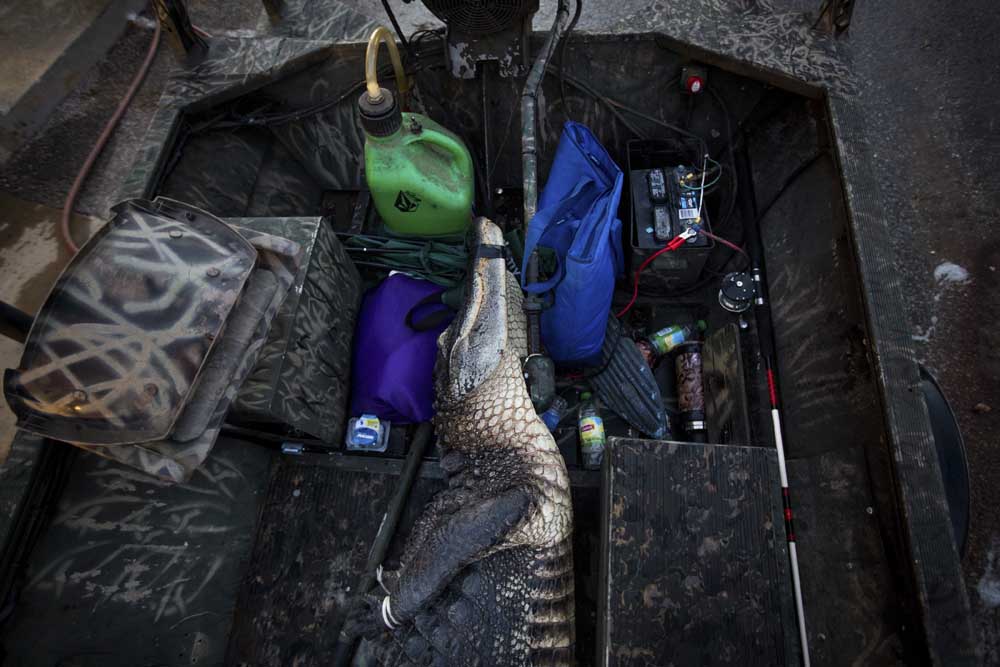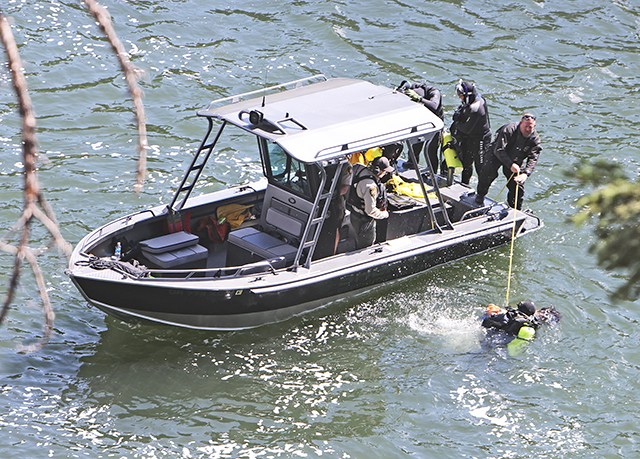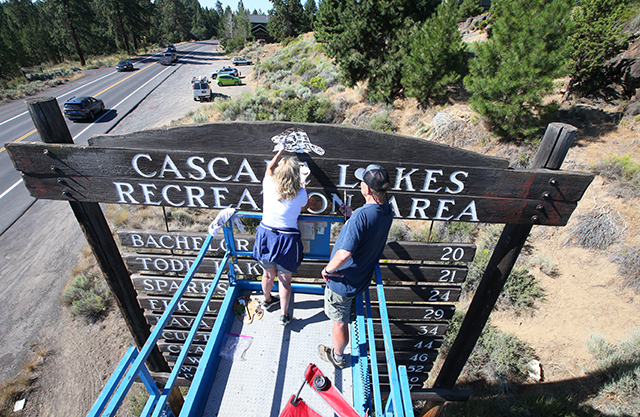Gator hunting in ‘Bama, and nothing to do with football
Published 12:00 am Sunday, August 23, 2015

- An alligator after being weighed and measured in Spanish Fort, Alabama.
BAY MINETTE, Ala. —
When alligator season began Aug. 13 in Alabama, those lucky enough to receive one of the state’s 260 prized hunting permits wondered if they might do what Mandy Stokes did last year. She and four others captured and killed the largest American alligator on record.
Trending
With the sky’s last light flickering like dying fire on the Tensaw River, people slipped their boats into the still water, disappeared into the dark maze of creeks and bayous, and went looking for the biggest alligator they could find.
Spotting them is the easy part. Alligators generally hug the shores at night, their reptilian bodies hidden beneath the murky surface, often deathly still. But their eyes, usually just above the waterline, reflect light. A flashlight with a strong beam creates a sparkle from hundreds of yards away, like headlights igniting a reflector far ahead on a lonely road.
The trick is not finding an alligator, but finding one worthy of the time and effort required to capture it. Most want a 10-footer. The one Stokes found, 100 miles north of here, was 15 feet long, and it weighed more than 1,000 pounds. Its stomach contained the front and rear halves of an adult white-tailed deer, a pair of squirrel carcasses, the bones of a duck, and teeth believed to be from a young cow.
“Hunting something that can hunt you back — that’s kind of cool,” said Carlos Garcia, waiting for sunset at the Cliff’s Landing boat launch. A departing fisherman rolled to a stop in his truck, whispered that he had spotted a 15-footer on Middle River and drove off.
Soon, off the hunters went, disappearing into the moonless night, mostly in fishing boats about the length of the Stokes gator, armed with fishing poles, harpoons and a shotgun, used only after the animal has been strapped to the boat.
“It’s hunting and fishing in one,” Brandon Wailes said before he, Garcia and their crew headed out.
Trending
Off went Jake Rosser and two friends in the popular, compact G3, the Honda Accord of fishing boats. A pontoon boat with a multigenerational crew of seven launched at 8:01 p.m. A confident trio of burly men arrived late, said that they were veterans of a dozen successful alligator hunts over in Mississippi, and quickly motored upriver.
A retiree named Lou Wallace donned a captain’s hat and carried his wife, Shirley, and a friend in his small boat. They towed a homemade wooden platform to carry back their presumed prize. They brought a towel that they had soaked in water and rubbed on their dog.
“They love that dog scent,” Wallace said of alligators. Back home, the head of a 12-foot alligator sat on the hearth.
They and dozens of others, from launches across the southern half of the state, trolled the waters, some as wide as a runway, others as narrow and serpentine as a country road.
The banks were slate silhouettes, a barely perceptible skyline of tall grasses in the south and walls of cypress trees farther north. The water was as still and black as the sky. The running light on the stern of each boat was like a slow-moving shooting star, mirroring the meteor shower above. Spotlights scanned the banks. Alligator eyes shone back like gemstones.
Successful hunters came back in the middle of the night, or when dawn broke, with a dead-eyed and limp alligator, the skin loose in the middle, the jaw shut with tape, a blood-red hole in the top of the skull.
The hunters carried tales of sizing up the alligator, estimating its underwater length by the distance between the eyes and the tip of its nose — an inch of snout equals about a foot of alligator. They cast weighted lines with three-pronged treble hooks, shaped like miniature chandeliers, over the top of the alligator, reeling them back to try to catch its thick skin.
It is where most alligator battles are won or lost. Some hooks caught in the alligator’s hide, but most missed or snagged on unseen roots or lilies. Either way, the alligator usually slipped silently underwater, like a submarine, starting an onboard scramble to figure out where it had gone.
Then the wait began: Alligators can hold their breath for an hour or more.
When it finally rose, it shot up, snout first, shattering the surface’s calm. More hooks were cast, or a harpoon was jabbed into its side, which usually sent it underwater again, but not for so long. Weakening, the alligator was jabbed again, or its tail or snout was snared in a wire hoop.
Once the alligator was coaxed to the edge of the boat and its size was estimated by everyone on board, the group would agree either to let it go or to shoot it in the back of the head.
You get only one alligator. Make it a good one.
Bigger in Alabama
The record alligator has no name, but most people call it the Stokes gator. It is taxidermy now, its insides filled mostly with foam, its thick hide clean and shiny, its mouth forever opened slightly. Somehow, its breath still stinks.
The tail hangs off one end of a sturdy table, almost touching the floor, 15 feet from the snout. The alligator lies on grass and straw amid small bushes and cattails.
“My husband had the table made in Thomasville,” Mandy Stokes said. “And we went to Hobby Lobby to find the closest thing we could figure to swamp vegetation.”
Alabama has far fewer alligators than the other Southern states that the animal, part of the order Crocodilia and scientifically named Alligator mississippiensis, calls home. To control populations, Florida hands out roughly 5,000 hunting permits each year, each good for up to two alligators, compared with the 260 this year in Alabama that are good for just one apiece.
For now, though, Alabama can boast that it has the biggest. On Aug. 13, Stokes, a 35-year-old mother of two young children, with blond hair and a big voice with a thick drawl, stood inside the Gee’s Bend Ferry terminal near Camden, where the Stokes gator was on display for most of the month. It had been caught a few miles north, not far from where state Highway 28 crosses Majors Creek.
Every few minutes, people pulled up in their cars and sauntered in. They circled the alligator with curiosity and took photographs. Many of them greeted Stokes, who grew up in Pine Hill, works as an office manager at a veterinary clinic in Camden, and is a celebrity in Wilcox County because of what happened a year ago.
Stokes was experienced in the outdoors — fishing, hunting and frog gigging — but had never been alligator hunting. When her name was pulled from a pool of about 5,000 applicants statewide last year, she was granted a permit in the West-Central region, where she lives.
She brought her husband, John; her sister’s husband, Kevin Jenkins; and his two teenagers, Savannah and Parker. They borrowed a boat.
“We had heard there was a big one at the dam, over at Mill Creek,” Stokes said. Just before the season began, a dog had waded into the water there and did not come out. Big alligator footprints were found on shore.
Safari Club International measured the skin and detached head at a combined 15 feet 9 inches, declaring it more than a foot longer than the previous record, set in Texas in 2007. The hide was sent to a tannery in New York. In May, the reassembled alligator was unveiled publicly in Montgomery. Researchers in Florida concluded that the Stokes gator, despite myths of larger beasts caught decades ago, was worthy of the size record.
“To our knowledge, this is the largest American alligator yet documented by professional biologists using standardized methods that can be validated with physical evidence,” their report concluded.
On a string of leather around Stokes’s neck hung a scute, one of the bony ridges that line an alligator’s back. She drank from a Florida Gators tumbler. (The rare Alabamian who roots for Florida football, she named her son Tebow.)
She would love to keep the alligator, but it needs a climate-controlled home, and there is no room in her house for that. Someone offered to buy it for $15,000. (“They’re way off,” she said. It had cost nearly that much to prepare it for presentation.) Maybe it will end up in a museum, which would make Stokes happy, too.
Weighing the prize
Through the dark, Chris Nix steered his boat up the Tensaw River, part of a tangled braid of marshy channels that move without urgency toward Mobile Bay.
Most of Alabama’s alligator hunting happens in the Mobile-Tensaw River Delta, on six nights over two weekends. Few know the geography better than Nix, a wildlife biologist for the Alabama Department of Conservation and Natural Resources.
He oversees the state’s annual alligator hunt. Each year, he conducts a population survey, spending nights shining lights and counting eyes on the bank of every lake and creek and bayou he can navigate into. Alabama was the first state to protect the alligator, in the 1930s. It was added to the federal list of endangered species in 1967 and removed in 1987. After many ups and downs, the alligator population has been steady for years.
“Do I think there is another alligator out here that big?” Nix said of the Stokes gator. “I don’t know. I never thought there was one that big to start with.”
Nix, 40, has a tight haircut and a calm disposition. He was in uniform, and he carried a pistol on his belt. He approached three men in a boat and flashed his own boat’s blue lights to signal that he was an officer.
The men had an alligator alongside their boat. A harpoon had caught it in the snout. Black tape held its mouth closed.
“How big is he?” Nix asked. The average of the 147 alligators caught last year in Alabama was 9 feet 2 inches and 235 pounds.
“About 81⁄2,” one man said. It was always a guess.
They were not sure whether to keep it. After some debate, they wriggled the hooks free, carefully unwound the tape around the alligator’s snout and watched it slink into the murk.
“There are a lot more alligators around here,” one of the men, Greg Hall, said. “You always want one bigger than you get.”
Far to the north, in a shallow cove on snake-shaped Mifflin Lake, the Big Dipper hanging like a string of lanterns just above the cypress trees, Jessie Peacock and his family cornered a promising alligator.
“I ain’t seen a nose that big in a long time,” Peacock said as he navigated closer.
He and his crew lobbed three hooks toward the alligator. It sank into the black, and the hooks caught nothing but downed logs. The boat circled. Spotlights searched in desperation. The boat paced the cove, searching for movement and glowing eyes.
A 7-foot alligator swam nearby, coming close to the boat, as if taunting the hunters for their greed. After a couple of hours, the Peacock party gave up, passed a dozen or more other alligators lurking near the banks and made plans to return the next weekend.
At the check-in station in Spanish Fort, a crew of wildlife officers and biologists waited for alligators to arrive. There was a report that the first one caught in the West-Central region, about 100 miles north of where the Stokes gator was found, was a 13-footer. The hunter was not Mandy Stokes; she applied for a tag again this year but did not get one.
Now and again, trucks towing a boat pulled into the parking lot and stopped in front of a garage. Out of the trucks stepped excited and exhausted hunters. Inside each boat was a limp alligator.
Workers wrapped it in chains and hoisted it with a winch. A digital scale gave the weight. The tails of the biggest ones sagged to the ground and had to be tied up to get an accurate reading. The girth of the belly and tail were measured with a tape.
Smiling hunters posed for pictures before the alligator was lowered to the concrete. Chalk marked the tip of the tail and the tip of the snout, and the distance was measured. A tag was placed into the tip of the tail. Two students from the Dauphin Island Sea Lab asked if they could collect tissue samples. If so, they gouged the top of the head and part of a foot and cut off a claw.
Some hunters wanted the meat to eat, the skin for wallets or belts, the claws for jewelry. Some wanted just the head as a trophy. Few planned on stuffing the whole body. Most were not quite sure what to do with a dead 10-foot alligator.
“You ladies want that for research?” one hunter asked the students.
“We’ll take it if you don’t want it,” said Caitlin Wessel, a doctoral student.
By the first morning, she had four headless alligators wrapped in tarps and ice in the bed of a pickup truck. Twelve other alligators went home with their captors in the back of a boat.
By the end of the weekend, 49 alligators were captured in the Mobile-Tensaw River Delta, and a couple of dozen more in the three other regions around the state. None of them came particularly close to 15 feet or 1,000 pounds.
For now, the Stokes gator survives, empty of life but still a target, on display for anyone curious to know just how big an alligator can be.







